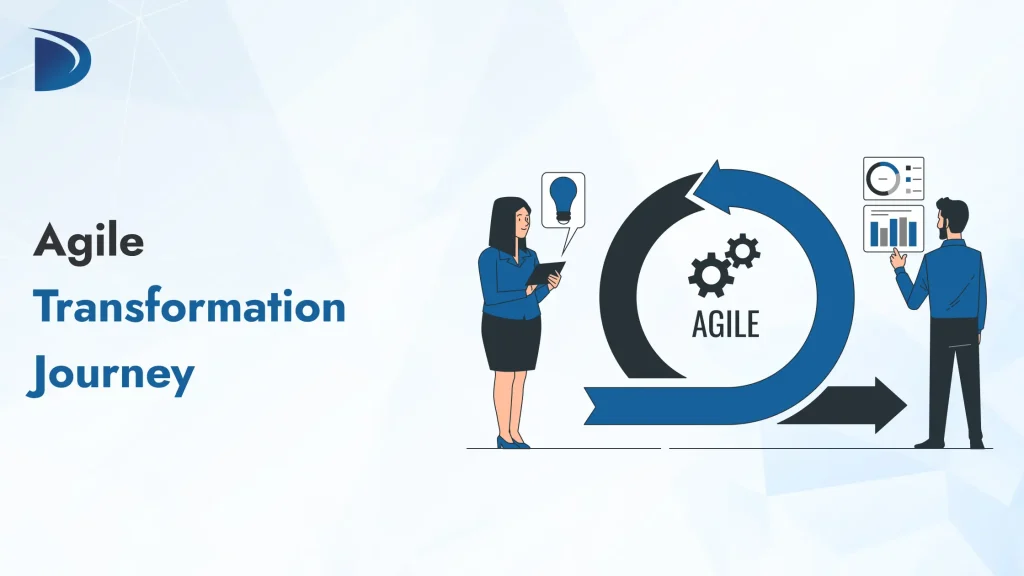Table of Contents
Adapting to change is no longer an option for businesses; it’s a necessity. Yet, when the path to improvement seems unclear, many turn to the Agile transformation journey to find their way. But what does it really take to make this shift?
Agile isn’t a one-size-fits-all solution – it requires a clear understanding of where you’re starting and where you want to go. In this blog, we’ll explore how Agile can reshape how your team works, the hurdles you might face, and what it takes to move past them. It’s not just about adopting new tools; it’s about making lasting change work for your business.
What is the Agile Transformation Journey?
The Agile transformation journey is the process by which an organization shifts from traditional project management and operational methods to Agile practices. It’s not just about implementing new tools or processes, but about changing the way teams work together and deliver value.
At its core, Agile focuses on flexibility, collaboration, and continuous improvement. Organizations moving through this transformation often begin by adopting Agile frameworks like Scrum or Kanban, which promote iterative development, quick feedbacks, and adaptability to change. However, the journey is deeper than just adopting these frameworks; it involves reshaping organizational culture, encouraging open communication, and fostering a mindset of collaboration and responsiveness across all levels.
Key cultural shifts include:
- Collaboration over hierarchy: Agile promotes cross-functional teams where members contribute ideas, decisions, and feedback, rather than working in isolated silos.
- Customer value focus: Agile prioritizes delivering value to customers through regular, incremental releases, rather than focusing on meeting rigid, predetermined deadlines.
- Embracing change: Agile encourages teams to be flexible and adjust based on feedback, changing market needs, or new insights, instead of strictly following initial plans.
Why Agile Transformation Journey?
- Adapts to Change: The Agile transformation journey helps businesses shift their mindset from rigid structures to more flexible, adaptive processes, making it easier to respond to market and customer demands.
- Faster Decision-Making: By implementing Agile principles, businesses can make quicker, more informed decisions. This speed enhances responsiveness and minimizes delays in product delivery.
- Increased Flexibility: Agile transformation enables organizations to continuously adjust their strategies and processes based on feedback, allowing them to pivot when needed without disrupting progress.
- Improved Collaboration: Agile transformation promotes cross-functional collaboration, breaking down silos between teams. This leads to better communication, faster problem-solving, and more effective solutions.
- Enhanced Efficiency: Through iterative cycles, Agile helps teams focus on delivering high-value features first, resulting in quicker outcomes and more efficient project execution.
- Customer-Centered Focus: The Agile transformation journey guarantees that businesses prioritize customer needs and feedback, creating products that align better with market demands and customer expectations.
Steps to an Agile Transformation Journey
The Agile transformation journey is a structured process that requires thoughtful planning and execution. Here are the essential steps to guide your business through this transition:
Step 1. Assess Your Current State
- Understand where your organization stands in terms of processes, culture, and readiness for change.
- Identify key challenges, bottlenecks, and areas for improvement in your current workflow.
Step 2. Define Clear Goals and Objectives
- Establish what you want to achieve through the Agile transformation (e.g., faster product delivery, improved customer satisfaction, better team collaboration).
- Align these goals with your overall business strategy to make sure the transformation adds value.
Step 3. Build Leadership Support
- Agile transformation requires strong leadership commitment.
- Leaders should understand and support the transformation process. They must advocate for the cultural shift and empower teams to make decisions.
Step 4. Choose the Right Agile Framework
- Select the Agile methodology that best fits your organization’s needs, such as Scrum, Kanban, or Lean.
- Customize the framework to align with your business goals and team structure.
Step 5. Provide Training and Resources
- Equip your team with the knowledge and skills necessary for Agile implementation. Training workshops, certifications, and hands-on coaching can be invaluable.
- Invest in tools that support Agile practices, such as project management software, to streamline communication and collaboration.
Step 6. Start with Pilot Projects
- Begin the transformation by applying Agile practices to a small, manageable project or team.
- This pilot project will allow you to test the new approach, identify challenges, and refine your processes before scaling across the organization.
Step 7. Refine and Learn
- Agile is all about improvement. Regularly review how things are going, ask for feedback, and make adjustments when needed.
- Create a learning environment where teams share what’s working, what’s not, and how to improve things.
Step 8. Scale Across the Organization
- Once the pilot project shows successful results, extend Agile practices to other teams and departments.
- Make sure the entire organization is aligned with the Agile mindset, promoting cross-functional collaboration and consistent practices.
Step 9. Monitor and Adapt
- Agile transformation is not a one-time project; it’s an ongoing process. Keep track of performance and adapt your approach as needed.
- Celebrate wins and acknowledge challenges to keep the momentum going and encourage a mindset of continuous improvement.
How to Make the Agile Transformation Journey Smooth?
The path to Agile transformation requires clear steps and a focus on key elements to ensure a successful shift. Here’s how you can make the journey smoother for your team:
i) Leadership Involvement
Just like any journey, a clear guide is needed. Leaders should actively support the change, providing direction and encouragement. Their involvement shows the team that the Agile transformation is a priority.
ii) Continuous Feedback
In any journey, feedback is crucial for progress. Encourage feedback from all team members regularly. This helps identify challenges early and allows for quick changes, making the journey more efficient and focused.
iii) Stay Flexible
The road isn’t always straight. As Agile transformation progresses, flexibility is key. Teams need to adjust plans based on feedback or changing circumstances to keep moving forward.
iv) Clear Communication
Communication keeps everyone aligned. In an Agile transformation journey, it’s important to regularly update and discuss goals, challenges, and progress, helping everyone move in the same direction.
v) Train Your Teams
Just like preparing for a journey, training is essential. Providing your teams with the right knowledge and tools helps them feel confident in adopting Agile practices and speeds up the transformation process.
vi) Start Small
Begin with a smaller team or project to see how Agile works. This is like taking small steps on a journey, allowing you to tackle any obstacles before expanding Agile practices to the larger organization.
vii) Be Patient
Every journey has its pace. Agile transformation doesn’t happen instantly, so it’s important to be patient. Give your team the time they need to adjust and improve as they move forward with Agile.
Overcoming Challenges in the Agile Transformation Journey
| Challenge | Description | How to Overcome It |
| Limited Cross-Department Collaboration | Agile focuses on team collaboration, but departments may still work in isolation. | Promote cross-department communication and collaboration early in the transformation. |
| Inadequate Tools and Resources | Teams may lack the necessary tools to implement Agile effectively. | Invest in the right tools to support Agile workflows, like project management software. |
| Unclear Success Metrics | Without clear goals, it’s hard to measure the progress of the transformation. | Define measurable goals and track them consistently to monitor success and make adjustments. |
| Lack of Stakeholder Engagement | Key stakeholders might not be fully involved, slowing down decision-making. | Engage stakeholders early on and keep them informed and involved throughout the process. |
| Overemphasis on Speed Over Quality | Focusing too much on fast delivery can compromise product quality. | Balance speed with quality by ensuring that iterative cycles focus on delivering both value and quality. |
| Poor Change Management | Without structured change management, employees may feel overwhelmed or confused. | Implement clear change management practices and support systems to guide the team. |
| Failure to Adapt to Feedback | Teams may ignore or underutilize feedback, slowing down improvement. | Make feedback loops a priority, ensuring that feedback is actively used to improve processes. |
| Difficulty in Maintaining Momentum | The transformation process may lose momentum, leading to disengagement. | Celebrate small wins and recognize progress to keep the team motivated throughout the process. |
Conclusion:
The Agile transformation journey is not a one-time fix but a continuous process that shapes how businesses work and grow. By embracing change, focusing on collaboration, and making thoughtful adjustments, organizations can adapt more easily to evolving needs and customer expectations.
Although challenges may arise, the benefits of increased flexibility, faster decision-making, and better communication make the journey worthwhile. Agile transformation is about shifting mindsets, aligning goals, and continuously improving, creating a path to greater efficiency and success in the long run.
FAQs
Can Agile work for all types of organizations?
Agile can benefit most organizations, but it may require some adjustments based on the industry and team structure. It’s important to assess the current needs and readiness for change.
Can Agile be implemented without external help?
It’s possible, but having external consultants can speed up the process. They bring experience and expertise, helping to avoid common pitfalls.
How do you keep teams motivated during Agile transformation?
Keeping teams motivated involves celebrating small successes, providing continuous learning opportunities, and fostering a culture of openness and collaboration.
What are some signs that an organization is ready for Agile?
Signs of readiness include a willingness to change, a need for faster delivery and flexibility, and a focus on customer collaboration. Teams should also be open to continuous learning and feedback.
Can Agile be successful in remote or distributed teams?
Yes, Agile can work with remote or distributed teams. The key is maintaining strong communication and collaboration using digital tools that support Agile workflows and keep teams connected.

